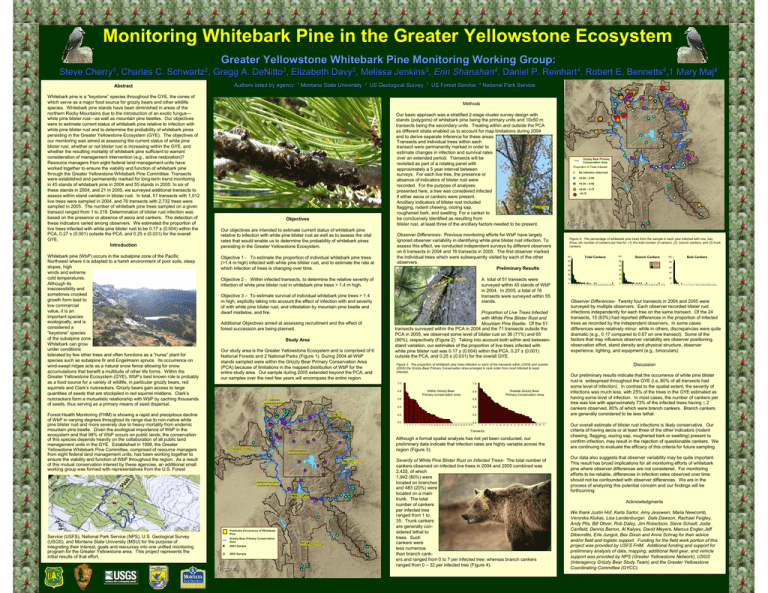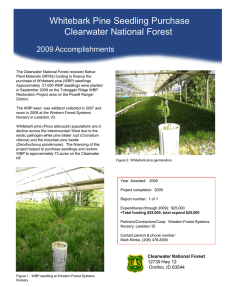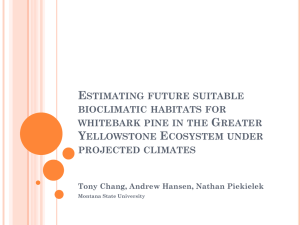Document 11089716
advertisement

Monitoring Whitebark Pine in the Greater Yellowstone Ecosystem Greater Yellowstone Whitebark Pine Monitoring Working Group: Steve Cherry1, Charles C. Schwartz2, Gregg A. DeNitto3, Elizabeth Davy3, Melissa Jenkins3, Erin Shanahan4, Daniel P. Reinhart4, Robert E. Bennetts4,1 Mary Maj4 Abstract Whitebark pine is a “keystone” species throughout the GYE, the cones of which serve as a major food source for grizzly bears and other wildlife species. Whitebark pine stands have been diminished in areas of the northern Rocky Mountains due to the introduction of an exotic fungus— white pine blister rust—as well as mountain pine beetles. Our objectives were to estimate current status of whitebark pine relative to infection with white pine blister rust and to determine the probability of whitebark pines persisting in the Greater Yellowstone Ecosystem (GYE). The objectives of our monitoring was aimed at assessing the current status of white pine blister rust, whether or not blister rust is increasing within the GYE, and whether the resulting mortality of whitebark pine sufficient to warrant consideration of management intervention (e.g., active restoration)? Resource managers from eight federal land management units have worked together to ensure the viability and function of whitebark pine through the Greater Yellowstone Whitebark Pine Committee. Transects were established and permanently marked for long-term trend monitoring in 45 stands of whitebark pine in 2004 and 55 stands in 2005. In six of these stands in 2004, and 21 in 2005, we surveyed additional transects to assess within stand variation in blister rust. In total, 51 transects with 1,012 live trees were sampled in 2004, and 76 transects with 2,732 trees were sampled in 2005. The number of whitebark pine trees sampled on a given transect ranged from 1 to 219. Determination of blister rust infection was based on the presence or absence of aecia and cankers. The detection of these indicators varied among observers. We estimated the proportion of live trees infected with white pine blister rust to be 0.17 ± (0.004) within the PCA, 0.27 ± (0.001) outside the PCA, and 0.25 ± (0.031) for the overall GYE. Introduction Whitebark pine (WbP) occurs in the subalpine zone of the Pacific Northwest where it is adapted to a harsh environment of poor soils, steep slopes, high winds and extreme cold temperatures. Although its inaccessibility and sometimes crooked growth form lead to low commercial value, it is an important species ecologically, and is considered a “keystone” species of the subalpine zone. Whitebark can grow under conditions tolerated by few other trees and often functions as a “nurse” plant for species such as subalpine fir and Engelmann spruce. Its occurrence on wind-swept ridges acts as a natural snow fence allowing for snow accumulations that benefit a multitude of other life forms. Within the Greater Yellowstone Ecosystem (GYE), WbP’s best known role is probably as a food source for a variety of wildlife, in particular grizzly bears, red squirrels and Clark’s nutcrackers. Grizzly bears gain access to large quantities of seeds that are stockpiled in red squirrel middens. Clark’s nutcrackers form a mutualistic relationship with WbP by caching thousands of seeds, thus serving as a primary means of seed dispersal. Forest Health Monitoring (FHM) is showing a rapid and precipitous decline of WbP in varying degrees throughout its range due to non-native white pine blister rust and more severely due to heavy mortality from endemic mountain pine beetle. Given the ecological importance of WbP in the ecosystem and that 98% of WbP occurs on public lands, the conservation of this species depends heavily on the collaboration of all public land management units in the GYE. Established in 1998, the Greater Yellowstone Whitebark Pine Committee, comprised of resource managers from eight federal land management units, has been working together to ensure the viability and function of WbP throughout the region. As a result of this mutual conservation interest by these agencies, an additional small working group was formed with representatives from the U.S. Forest Authors listed by agency: 11 Montana State University, 22 US Geological Survey; 33 US Forest Service, 44 National Park Service Methods Ants feeding on a canker Objectives Our objectives are intended to estimate current status of whitebark pine relative to infection with white pine blister rust as well as to assess the vital rates that would enable us to determine the probability of whitebark pines persisting in the Greater Yellowstone Ecosystem. Objective 1 - To estimate the proportion of individual whitebark pine trees (>1.4 m high) infected with white pine blister rust, and to estimate the rate at which infection of trees is changing over time. Observer Differences- Previous monitoring efforts for WbP have largely ignored observer variability in identifying white pine blister rust infection. To assess this effect, we conducted independent surveys by different observers on 6 transects in 2004 and 18 transects in 2005. The first observer marked the individual trees which were subsequently visited by each of the other observers. Preliminary Results Grizzly Bear Primary Conservation Area Proportion of Trees Infected No infection observed >0.00 – 0.25 >0.25 – 0.50 >0.50 – 0.75 >0.75 Figure Figure 3. 3. Figure 4. The percentage of whitebark pine trees from the sample in each year infected with one, two, three, etc number of cankers per tree for (1) the total number of cankers, (2) branch cankers, and (3) trunk cankers. 60 Total Cankers Objective 3 – To estimate survival of individual whitebark pine trees > 1.4 m high, explicitly taking into account the effect of infection with and severity of with white pine blister rust, and infestation by mountain pine beetle and dwarf mistletoe, and fire. Additional Objectives aimed at assessing recruitment and the effect of forest succession are being planned. Study Area Our study area is the Greater Yellowstone Ecosystem and is comprised of 6 National Forests and 2 National Parks (Figure 1). During 2004 all WbP stands sampled were within the Grizzly Bear Primary Conservation Area (PCA) because of limitations in the mapped distribution of WbP for the entire study area. Our sample during 2005 extended beyond the PCA, and our samples over the next few years will encompass the entire region. Proportion of Live Trees Infected with White Pine Blister Rust and Mountain Pine Beetle- Of the 51 transects surveyed within the PCA in 2004 and the 71 transects outside the PCA in 2005, we observed some level of blister rust on 36 (71%) and 65 (86%), respectively (Figure 2). Taking into account both within and betweenstand variation, our estimates of the proportion of live trees infected with white pine blister rust was 0.17 ± (0.004) within the PCA, 0.27 ± (0.001) outside the PCA, and 0.25 ± (0.031) for the overall GYE. Figure 2. The proportion of whitebark pine trees infected on each of the transects within (2004) and outside (2005) the Grizzly Bear Primary Conservation Area arranged in rank order from most infected to least infected. 1.0 0.8 Gallatin National Forest Custer National Forest A total of 51 transects were surveyed within 45 stands of WbP in 2004. In 2005, a total of 76 transects were surveyed within 55 stands. 1.0 Within Grizzly Bear Primary Conservation Area 0.6 0.4 0.4 0.2 0.0 Outside Grizzly Bear Primary Conservation Area 0.8 0.6 0.2 0.0 1 3 5 7 9 11 13 15 17 19 21 23 25 27 29 31 33 35 37 39 41 43 45 47 49 51 1 5 9 13 17 21 25 29 33 37 41 45 49 53 57 61 65 69 73 Transects Beaverhead-Deerlodge National Forest Although a formal spatial analysis has not yet been conducted, our preliminary data indicate that infection rates are highly variable across the region (Figure 3). Yellowstone National Park Shoshone National Forest Grand Teton National Park Predicted Occurrence of Whitebark Pine Grizzly Bear Primary Conservation Area 2004 Sample 2005 Sample Figure 1. 1. Bridger-Teton National Forest Severity of White Pine Blister Rust on Infected Trees- The total number of cankers observed on infected live trees in 2004 and 2005 combined was 2,425, of which 1,942 (80%) were located on branches and 483 (20%) were located on a main trunk. The total number of cankers per infected tree ranged from 1 to 35. Trunk cankers are generally considered lethal to trees. Such cankers were less numerous than branch cankers and ranged from 0 to 7 per infected tree; whereas branch cankers ranged from 0 – 32 per infected tree (Figure 4). 60 50 50 40 40 30 30 2004 2005 1 3 5 7 9 11 13 15 17 19 21 23 25 27 29 31 33 35 0 100 Bole Cankers 80 60 40 20 10 10 0 Branch Cankers 20 20 Aecia Objective 2 - Within infected transects, to determine the relative severity of infection of white pine blister rust in whitebark pine trees > 1.4 m high. Caribou-Targhee National Forest Service (USFS), National Park Service (NPS), U.S. Geological Survey (USGS), and Montana State University (MSU) for the purpose of integrating their interest, goals and resources into one unified monitoring program for the Greater Yellowstone area. This project represents the initial results of that effort. Our basic approach was a stratified 2-stage cluster survey design with stands (polygons) of whitebark pine being the primary units and 10x50 m transects being the secondary units. Treating within and outside the PCA as different strata enabled us to account for map limitations during 2004 and to derive separate inference for these areas. Transects and individual trees within each transect were permanently marked in order to estimate changes in infection and survival rates over an extended period. Transects will be revisited as part of a rotating panel with approximately a 5 year interval between surveys. For each live tree, the presence or absence of indicators of blister rust were recorded. For the purpose of analyses presented here, a tree was considered infected if either aecia or cankers were present. Ancillary indicators of blister rust included Flagging flagging, rodent chewing, oozing sap, roughened bark, and swelling. For a canker to be conclusively identified as resulting from blister rust, at least three of the ancillary factors needed to be present. 1 3 5 7 9 11 13 15 17 19 21 23 25 27 29 31 33 35 0 1 3 5 7 9 11 13 15 17 19 21 23 25 27 29 31 33 35 Observer Differences- Twenty four transects in 2004 and 2005 were surveyed by multiple observers. Each observer recorded blister rust infections independently for each tree on the same transect. Of the 24 transects, 15 (63%) had reported differences in the proportion of infected trees as recorded by the independent observers. In some cases differences were relatively minor, while in others, discrepancies were quite dramatic (e.g., 0.17 compared to 0.67 on one transect). Some of the factors that may influence observer variability are observer positioning, observation effort, stand density and physical structure, observer experience, lighting, and equipment (e.g., binoculars). Discussion Our preliminary results indicate that the occurrence of white pine blister rust is widespread throughout the GYE (i.e, 80% of all transects had some level of infection). In contrast to the spatial extent, the severity of infections was much less, with 25% of the trees in the GYE estimated as having some level of infection. In most cases, the number of cankers per tree was low with approximately 73% of the infected trees having ≤ 2 cankers observed, 80% of which were branch cankers. Branch cankers are generally considered to be less lethal. Our overall estimate of blister rust infections is likely conservative. Our criteria of having aecia or at least three of the other indicators (rodent chewing, flagging, oozing sap, roughened bark or swelling) present to confirm infection, may result in the rejection of questionable cankers. We are continuing to evaluate the efficacy of this criteria for future sampling. Our data also suggests that observer variability may be quite important. This result has broad implications for all monitoring efforts of whitebark pine where observer differences are not considered. For monitoring efforts to be reliable, differences in infection rates observed over time should not be confounded with observer differences. We are in the process of analyzing this potential concern and our findings will be forthcoming. Acknowledgments We thank Justin Hof, Karla Sartor, Amy Jesswein, Maria Newcomb, Veronika Klukas, Lisa Landenburger, Dale Dawson, Rachael Feigley, Andy Pils, Bill Oliver, Rob Daley, Jim Robertson, Steve Schadt, Jodie Canfield, Dennis Barron, Al Kalyes, David Meyers, Marcus Engler,Jeff Dibennitto, Erle Jungck, Bev Dixon and Anne Schrag for their advice and/or field and logistic support. Funding for the field work portion of this project was provided by USFS FHM. Additional funding and support for preliminary analysis of data, mapping, additional field gear, and vehicle support was provided by NPS (Greater Yellowstone Network), USGS (Interagency Grizzly Bear Study Team) and the Greater Yellowstone Coordinating Committee (GYCC).




